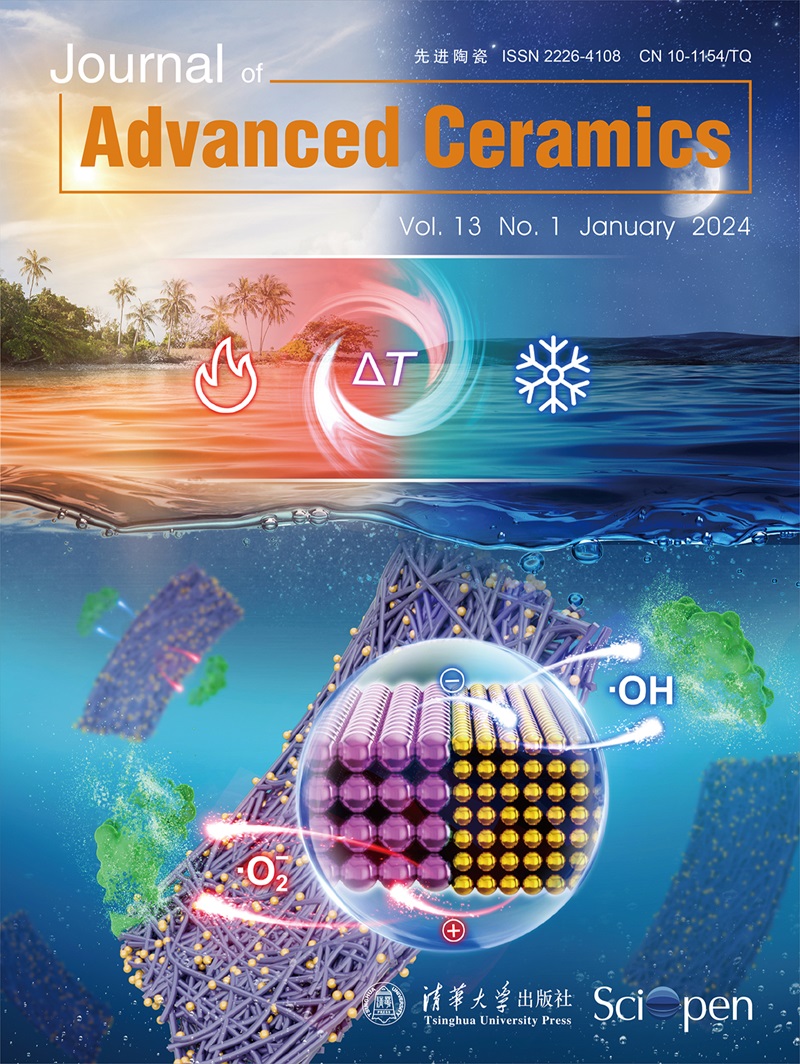纳米晶NiCuZn铁氧体弹性模量的热变化
IF 16.6
1区 材料科学
Q1 MATERIALS SCIENCE, CERAMICS
引用次数: 3
摘要
采用微波水热法制备了粒径为20 nm的Ni0.38Cu0.12Zn0.5Fe2O4纳米粉体,并对其进行了表征。然后在空气中对铁素体样品在不同温度下进行微波烧结,并对其进行表征。在室温下测量了磁性能。在1mhz下测量了烧结试样的介电常数()、初始磁导率()和质量因子()。在300 ~ 600 K的温度范围内测量了初始渗透率的热变化。在300 K - 600 K的温度下,采用复合压电振荡器方法对NiCuZn铁氧体的弹性行为进行了详细的研究。发现室温弹性模量与样品有轻微的相关性,并且随着温度的升高而减小,除了在居里温度附近观察到一个小的异常。室温下的内摩擦也与颗粒大小有关。内摩擦的温度变化在500 K左右表现出较大的最大值,刚好低于居里温度530 K。上述观察是在消磁状态下进行的;400 mT磁场的应用使我们能够在任何测量温度下达到样品的饱和状态。利用磁晶各向异性常数的温度变化解释了弹性模量和内摩擦的热变化异常。本文章由计算机程序翻译,如有差异,请以英文原文为准。
Thermal Variation of Elastic Modulus on Nanocrystalline NiCuZn Ferrites
The nanopowders of Ni0.38Cu0.12Zn0.5Fe2O4 with particle size, 20 nm have been synthesised using Microwave-Hydrothermal method and characterized. Then the ferrite samples were microwave sintered at different temperatures in an air atmosphere and characterized. The magnetic properties were measured at room temperature. The dielectric constant (), initial permeability () and quality factor () has been measured on sintered samples at 1 MHz. Thermal variation of initial permeability has been measured over temperature range of 300 K–600 K. A detailed study of elastic behaviour of NiCuZn ferrites has been under taken using a composite piezoelectric oscillator method over a temperature of 300 K–600 K. The room temperature elastic moduli is found to be slightly sample dependent and decreases with increasing the temperature, except near the Curie temperature, , where a small anomaly is observed. The internal friction at room temperature is also found to be more particle size dependent. The temperature variation of internal friction exhibits a broad maximum around 500 K, just below Curie temperature 530 K. The above observations were carried on in the demagnetized state; on the application of a 400 mT magnetic field allowed us to reach the saturated state of the sample at any of the measuring temperature. The anomaly observed in the thermal variation of elastic moduli and internal friction is explained with the help of temperature variation of magneto-crystalline anisotropy constant.
求助全文
通过发布文献求助,成功后即可免费获取论文全文。
去求助
来源期刊

Journal of Advanced Ceramics
MATERIALS SCIENCE, CERAMICS-
CiteScore
21.00
自引率
10.70%
发文量
290
审稿时长
14 days
期刊介绍:
Journal of Advanced Ceramics is a single-blind peer-reviewed, open access international journal published on behalf of the State Key Laboratory of New Ceramics and Fine Processing (Tsinghua University, China) and the Advanced Ceramics Division of the Chinese Ceramic Society.
Journal of Advanced Ceramics provides a forum for publishing original research papers, rapid communications, and commissioned reviews relating to advanced ceramic materials in the forms of particulates, dense or porous bodies, thin/thick films or coatings and laminated, graded and composite structures.
 求助内容:
求助内容: 应助结果提醒方式:
应助结果提醒方式:


